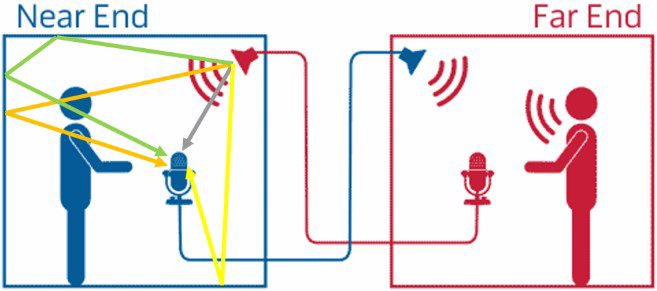Audio Echo Cancellation (AEC)
Audio Echo Cancellation (AEC) is a signal processing technique designed to eliminate acoustic feedback caused by a system's own output being re-captured by its input—commonly occurring in full-duplex communication systems like speakerphones, conferencing systems, or voice assistants.
Problem Context
In a typical hands-free setup:
-
A far-end voice is played through a loudspeaker.
-
That audio is picked up again by the system’s microphone (along with the near-end speaker’s voice).
-
The far-end user hears their own voice echoed back, with a delay.
AEC aims to remove this echo path contribution from the microphone signal, enabling clear full-duplex communication.
ANC – Active Noise Cancellation (or Control)
Definition:
ANC is a real-time signal processing technique that uses destructive interference to cancel out ambient noise. It generates an anti-noise signal that is phase-inverted relative to the unwanted sound, thereby reducing the perceived noise at the ear or microphone.
Core Concepts:
-
Feedback ANC: Uses a microphone placed inside the headphone or near the ear to monitor the resulting sound. It's used to cancel low-frequency noise that leaks through passive isolation.
-
Feedforward ANC: Uses external microphones to capture ambient noise and generate anti-noise before it reaches the ear.
-
Hybrid ANC: Combines both feedforward and feedback microphones for better broadband cancellation.
ENC – Environmental Noise Cancellation
Definition:
ENC refers to microphone signal processing that removes environmental noise from voice capture signals, improving intelligibility of speech during communication (e.g., phone calls, voice assistants, or conferencing).
Core Concepts:
-
Utilizes multiple microphones to distinguish between speech (near-field) and noise (far-field).
-
Employs beamforming, spectral subtraction, Wiener filtering, or DNN-based noise suppression to isolate and enhance speech.
NOTE: Active Noise Cancellation (ANC) reduces unwanted ambient sounds in various environments, like offices, airplanes, and busy streets, to create a quieter experience for listening or focusing. Environmental Noise Cancellation (ENC) minimizes background noise during calls, making your voice clearer to the person on the other end.
Why All Three DSP Features Are Needed
| Feature | Role in TWS Earbuds | Why It’s Needed |
|---|---|---|
| ANC (Active Noise Cancellation) | Reduces unwanted environmental noise for the listener, improving audio immersion and speech intelligibility. | In noisy settings (train, plane, street), ANC suppresses low-frequency noise like engine hum, allowing the user to clearly hear music or voices. |
| ENC (Environmental Noise Cancellation) | Removes ambient noise from the user’s outgoing voice, so remote callers hear clean speech. | Without ENC, the far-end caller hears background chatter, traffic, wind, etc. ENC isolates the near-field (mouth) signal from far-field noise using multiple mics and beamforming. |
| AEC (Acoustic Echo Cancellation) | Removes playback audio (e.g., other caller’s voice) that leaks into the mic during calls. Prevents far-end echo. | When the user talks with someone over a call, the far-end speaker's voice is played through the earbud speakers. The mic can pick this up, causing echo unless cancelled. AEC ensures clean full-duplex conversations. |






Comments
Post a Comment